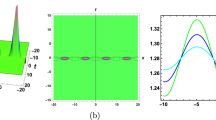Abstract
Nonlinear interactions of the two-dimensional (2D) second mode with oblique modes are studied numerically in a Mach 6.0 flat-plate boundary layer, focusing on its selective enhancement effect on amplification of different oblique waves. Evolution of oblique modes with various frequencies and spanwise wavenumbers in the presence of 2D second mode is simulated successively, using a modified parabolized stability equation (PSE) method, which is able to simulate interaction of two modes with different frequencies efficiently. Numerical results show that oblique modes in a broad band of frequencies and spanwise wavenumbers can be enhanced by the finite amplitude 2D second mode instability wave. The enhancement effect is accomplished by interaction of the 2D second mode, the oblique mode, and a forced mode with difference frequency. Two types of oblique modes are found to be more amplified, i.e., oblique modes with frequency close to that of the 2D second mode and low-frequency first mode oblique waves. Each of them may correspond to one type of transition routes found in transition experiments. The spanwise wavenumber of the oblique wave preferred by the nonlinear interaction is also determined by numerical simulations.
Similar content being viewed by others
References
Mack, L. M. Review of linear compressible stability theory. Stability of Time Dependent and Spatially Varying Flows (eds. Dwoyer D. L. and Hussaini, M. Y.), Springer, New York, 164–187 (1987)
Herbert, T. Secondary instability of boundary layers. Annual Review of Fluid Mechanics, 20(1), 487–526 (1988)
Kachanov, Y. S. Physical mechanisms of laminar-boundary-layer transition. Annual Review of Fluid Mechanics, 26(1), 411–482 (1994)
Li, X., Fu, D., and Ma, Y. Direct numerical simulation of hypersonic boundary layer transition over a blunt cone. AIAA Journal, 46(11), 2899–2913 (2008)
Li, X., Fu, D., and Ma, Y. Direct numerical simulation of hypersonic boundary layer transition over a blunt cone with a small angle of attack. Physics of Fluids (1994–present), 22(2), 025105 (2010)
Liu, J. X. Evolution of Disturbance in Hypersonic Blunt Cone Boundary Layer at a Small Angle of Attack (in Chinese), Ph. D. dissertation, Tianjin University (2010)
Yu, M. and Luo, J. S. Nonlinear evolution of Klebanoff type second mode disturbances in supersonic flat-plate boundary layer. Applied Mathematics and Mechanics (English Edition), 35(3), 359–368 (2014) DOI 10.1007/s10483-014-1796-8
Yu, M. and Luo, J. S. Nonlinear interaction mechanisms of disturbances in supersonic flat-plate boundary layers. Science China Physics, Mechanics and Astronomy, 57(11), 2141–2151 (2014)
Chou, A., Ward, C. A. C., Letterman, L. E., Luersen, P. K., Borg, M. P., and Schneider, S. P. Transition research with temperature-sensitive paints in the Boeing/AFOSR Mach-6 quiet tunnel. 41st AIAA Fluid Dynamics Conference and Exhibit, American Institute of Aeronautics and Astronautics, Honolulu (2011)
Sivasubramanian, J. and Fasel, H. F. Numerical investigation of laminar-turbulent transition for a flared cone at Mach 6. 54th AIAA Aerospace Sciences Meeting, AIAA SciTech, San Diego (2016)
Shiplyuk, A. N., Maslov, A. A., and Chokani, N. D. Nonlinear interactions of second mode instability with natural and artificial disturbances. 41st Aerospace Sciences Meeting and Exhibit, American Institute of Aeronautics and Astronautics, Reno (2003)
Bountin, D., Shiplyuk, A., and Maslov, A. Evolution of nonlinear processes in a hypersonic boundary layer on a sharp cone. Journal of Fluid Mechanics, 611, 427–442 (2008)
Dong, M. and Luo, J. S. Mechanism of transition in a hypersonic sharp cone boundary layer with zero angle of attack. Applied Mathematics and Mechanics (English Edition), 28(8), 1019–1028 (2007) DOI 10.1007/s10483-007-0804-2
Schneider, S. P. Developing mechanism-based methods for estimating hypersonic boundary-layer transition in flight: the role of quiet tunnels. Progress in Aerospace Sciences, 72, 17–29 (2015)
Zhu, Y., Zhang, C., Chen, X., Yuan, H., Wu, J., Chen, S., Lee, C., and Gad-el-Hak, M. Transition in hypersonic boundary layers: role of dilatational waves. AIAA Journal, 54(10), 3039–3049 (2016)
Gaponov, A. A. and Terekhova, N. M. Three-wave interactions between disturbances in the hypersonic boundary layer on impermeable and porous surfaces. Fluid Dynamics, 44(3), 362–371 (2009)
Wu, X. and Stewart, P. A. Interaction of phase-locked modes: a new mechanism for the rapid growth of three-dimensional disturbances. Journal of Fluid Mechanics, 316, 335–372 (1996)
Herbert, T. Parabolized stability equations. Annual Review of Fluid Mechanics, 29(1), 245–283 (1997)
Chang, C. L. Langley Stability and Transition Analysis Code (LASTRAC) Version 1.2 User Manual, NASA TM 213233, NASA Langley Research Center, Langley (2004)
Zhang, Y. and Zhou, H. PSE as applied to problems of transition in compressible boundary layers. Applied Mathematics and Mechanics (English Edition), 29(7), 833–840 (2008) DOI 10.1007/s10483-008-0701-8
Zhao, L., Zhang, C. B., Liu, J. X., and Luo, J. S. Improved algorithm for solving nonlinear parabolized stability equations. Chinese Physics B, 25(8), 084701 (2016)
Fang, Y., Luo, J., and Zhou, H. Numerical study of the coherent structures in wall region of a channel flow (in Chinese). Acta Mechanica Sinica, 27(5), 513–522 (1995)
Chang, C. L. and Malik, M. R. Oblique-mode breakdown and secondary instability in supersonic boundary layers. Journal of Fluid Mechanics, 273, 323–360 (1994)
Bertolotti, F. P. Linear and Nonlinear Stability of Boundary Layers with Streamwise Varying Properties, Ph. D. dissertation, The Ohio State University (1991)
Mayer, C. S. J., Fasel, H. F., Choudhari, M., and Chang, C. L. Transition onset predictions for oblique breakdown in a Mach 3 boundary layer. AIAA Journal, 52(4), 882–886 (2014)
Sivasubramanian, J. and Fasel, H. F. Direct numerical simulation of transition in a sharp cone boundary layer at Mach 6: fundamental breakdown. Journal of Fluid Mechanics, 768, 175–218 (2015)
Author information
Authors and Affiliations
Corresponding author
Additional information
Project supported by the National Natural Science Foundation of China (No. 11332007)
Rights and permissions
About this article
Cite this article
Zhang, C., Luo, J. Selective enhancement of oblique waves caused by finite amplitude second mode in supersonic boundary layer. Appl. Math. Mech.-Engl. Ed. 38, 1109–1126 (2017). https://doi.org/10.1007/s10483-017-2227-9
Received:
Revised:
Published:
Issue Date:
DOI: https://doi.org/10.1007/s10483-017-2227-9



